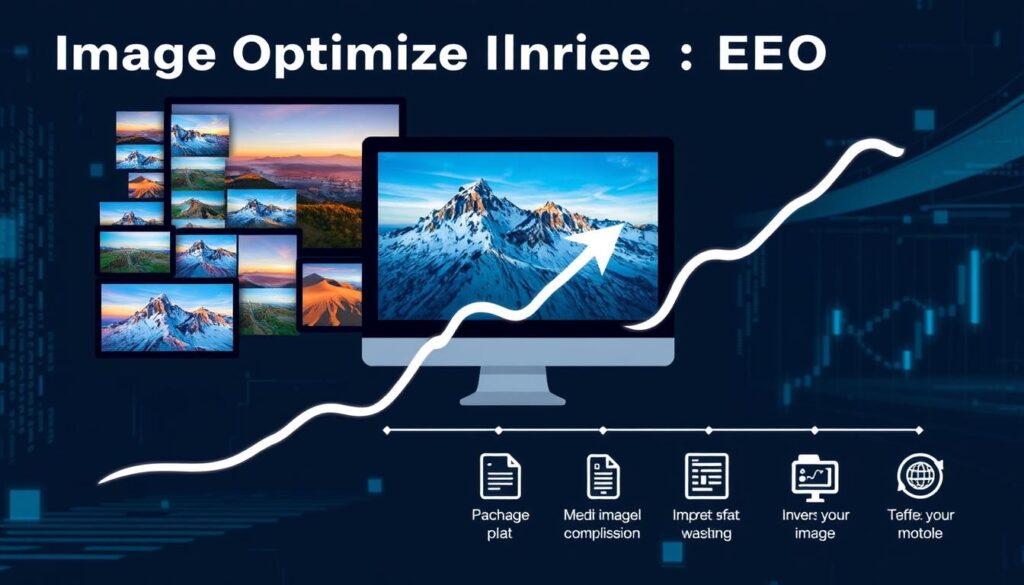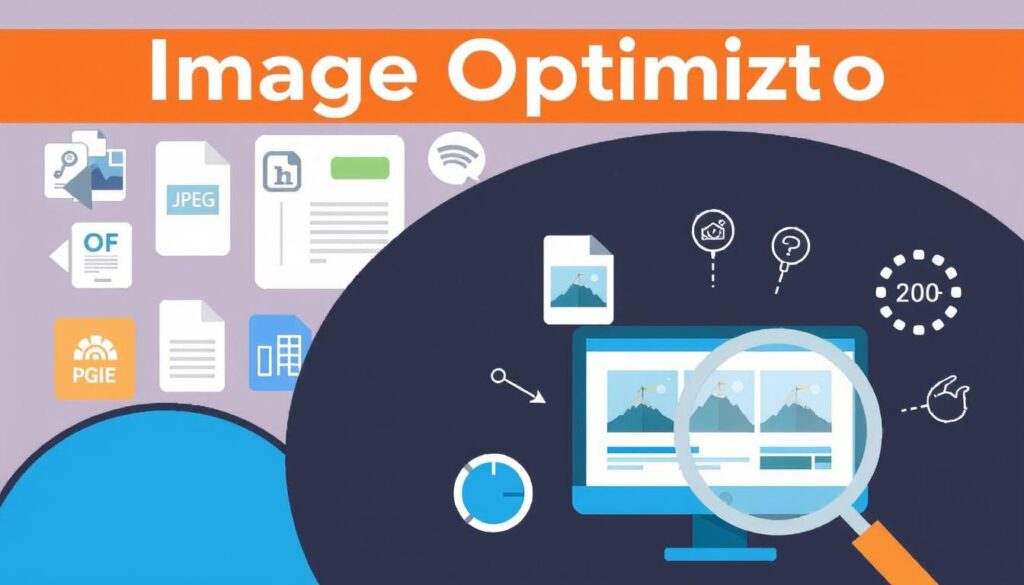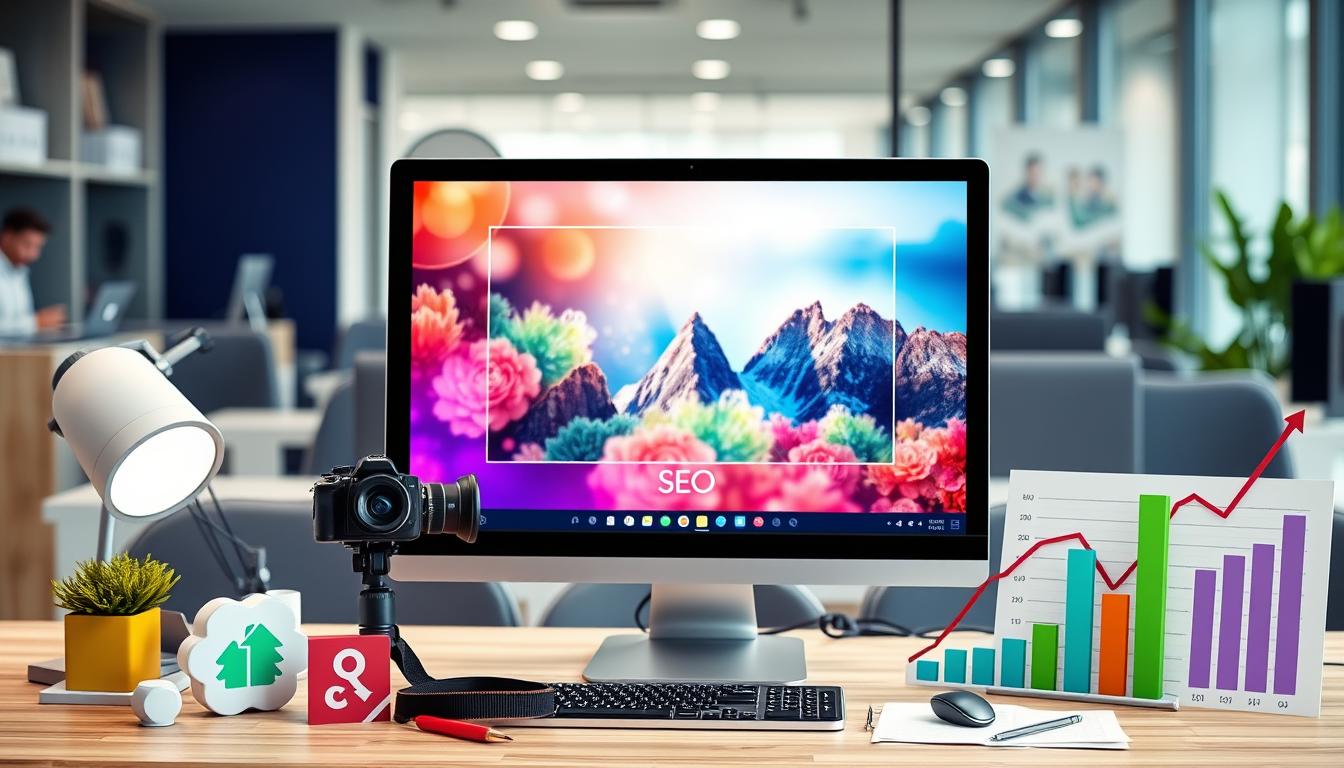Did you know that images account for over 60% of the total page weight of a website? This staggering statistic underscores the imperative for effective image optimization for SEO, particularly in 2023. As search engines evolve, they increasingly prioritize not just textual content but also the visual aspects of a site. By applying proven image optimization techniques, website owners and digital marketers can significantly enhance their online visibility, user engagement, and overall site performance.
In an era where user experience and site speed are paramount for rankings, mastering how to optimize images for SEO becomes essential. Proper image optimization for SEO can lead to faster load times, improved site performance, and a better overall impression on visitors. If you’re looking to stay ahead in the competitive online landscape, understanding and implementing effective SEO image optimization strategies is imperative.
To explore more about the impact of image optimization, check out the terms of use that discuss these principles in depth.
Key Takeaways
- Images significantly contribute to webpage loading times.
- Effective image optimization can enhance user experience.
- SEO practices increasingly focus on visual content.
- Utilizing the right formats can improve SEO performance.
- Mastering image optimization is essential for digital marketing success.
Why Image Optimization is Crucial for SEO
Image optimization is a cornerstone in the realm of SEO, significantly boosting website visibility and user experience. It is instrumental in enhancing page load times and overall site performance. Adherence to image optimization best practices is imperative for any successful SEO strategy.
Understanding SEO and Its Benefits
Search Engine Optimization (SEO) endeavors to elevate online visibility, thereby drawing in more traffic. By concentrating on SEO image optimization, enterprises can significantly boost their search engine rankings. Optimized images are a crucial element in digital marketing, contributing to improved search engine rankings.
The Role of Images in User Experience
Images are pivotal in crafting a superior user experience. They captivate attention, convey messages succinctly, and foster engagement. Effective image SEO ensures images enhance aesthetic appeal while maintaining optimal loading times. This enhances usability and encourages extended site interaction.
How Image Optimization Affects Page Load Speed
Page load speed is directly impacted by image optimization for SEO. Oversized images can cause slower loading times, leading to increased bounce rates. Users expect rapid access to information, and delays can lead to frustration. Therefore, understanding and implementing image optimization best practices is crucial to maintain site performance.
Key Principles of Image Optimization
Grasping the fundamental principles of image optimization is imperative for those aiming to elevate their website’s performance. Implementing optimal image optimization techniques can dramatically enhance load times and user experience. The selection of the appropriate image format, tailored to specific requirements, is pivotal for achieving superior results while adhering to established best practices.
Choosing the Right Image Format
The selection of image format is critical in determining how images are rendered and interacted with on a website. The dichotomy between raster and vector graphics is paramount. Raster images, encompassing formats such as JPEG and PNG, are ideal for photographs and intricate graphics. Conversely, vector formats, exemplified by SVG, are more suitable for logos and icons due to their inherent scalability.
- JPEG: Ideal for photographs where small file size is essential.
- PNG: Suitable for images that require transparency and detailed graphics.
- SVG: Perfect for logos and icons, ensuring clarity at any size.
Compressing Images Without Losing Quality
Effectively compressing images is a cornerstone of optimizing images for SEO while preserving their quality. Through the application of various compression techniques, it is feasible to diminish file sizes without compromising visual integrity. Tools such as TinyPNG and ImageOptim provide efficacious solutions for this endeavor. The adoption of these compression methods can expedite load times and enhance the overall user experience.
For additional insights on image optimization techniques, feel free to contact us. Adherence to these principles ensures the consistent implementation of image optimization best practices on your website.
Best Image File Formats for SEO
In the realm of image optimization for seo, the choice of file format is paramount. Each format possesses distinct advantages, rendering certain types more appropriate for specific applications. Mastery over these formats can profoundly elevate your image seo tactics and the overall efficacy of your website.
JPEG: Best for Photographs
JPEG emerges as the premier selection for photographs. Its prowess in compressing substantial files without compromising on quality renders it exemplary for this genre. As a lossy format, JPEG excels in reducing file sizes, thereby facilitating expedited loading times—a critical factor in optimizing images for seo. The widespread adoption of JPEG on websites stems from its harmonious blend of quality and size efficiency.
PNG: Ideal for Graphics
PNG emerges as the quintessential choice for graphics. Its capacity for transparency and lossless compression ensures that PNG files retain superior quality, rendering them ideal for logos and illustrations. This format guarantees crisp images, thereby bolstering image seo by ensuring visual clarity across diverse devices. The deployment of PNGs can markedly improve user engagement, particularly on sites replete with graphics.
WebP: The Next Gen Format
WebP heralds a paradigm shift in image formats. By amalgamating the strengths of JPEG and PNG, it achieves unparalleled compression, resulting in diminutive file sizes without compromising on quality. This avant-garde format promises to elevate site performance, thereby facilitating more effective image optimization for seo. With increasing browser support, WebP represents a cutting-edge solution for those vying to lead in image optimization.
How to Properly Resize Images
Optimal image resizing is paramount for effective image optimization techniques, significantly boosting website performance. Ensuring images are sized appropriately guarantees seamless display across various devices, particularly crucial for mobile users. This section outlines essential considerations.
Utilizing Image Dimensions
Adopting the correct dimensions tailored to your layout offers substantial benefits. Below are some critical image optimization best practices concerning sizing:
- Ascertain the dimensions your layout necessitates prior to uploading images.
- Employ tools to automatically resize images according to these specifications.
- Strike a balance between image quality and file size for enhanced load times.
Tips for Mobile Responsiveness
Given the increasing trend of mobile access, ensuring images are resized for mobile responsiveness is imperative. The following tips are designed to optimize images for mobile:
- Employ responsive design methodologies to serve images based on screen size.
- Utilize CSS media queries to dynamically adjust image dimensions.
- Implement lazy loading for images to expedite initial page load times.
Integrating these image optimization techniques into your workflow will undoubtedly improve user experience and engagement.
For additional insights on copyright and image usage, refer to DMCA policies to ensure adherence while elevating website quality.
Adding Alt Text: Best Practices
Alt text, or alternative text, is a pivotal component in the realm of image optimization for SEO. It offers a descriptive synopsis of an image, facilitating search engines’ comprehension of its content. This is essential not only for enhancing visibility but also for augmenting web accessibility. It empowers visually impaired users to grasp the context of an image, a function critical to the success of overall SEO strategies.
What is Alt Text and Why is it Important?
Alt text is a written description of an image that manifests in its stead when the image cannot be rendered. This attribute is instrumental in driving image alt text seo by ensuring accurate indexing of images by search engines. Adequate alt text provision guarantees that users reliant on screen readers receive contextual insights into the imagery on a webpage.
How to Write Effective Alt Text
Effective alt text composition necessitates clarity and pertinence. Adherence to the following best practices is imperative:
- Be descriptive: Clearly articulate the image’s depiction for both users and search engines.
- Keep it concise: Strive for a length of 125 characters or less, while ensuring the provision of critical context.
- Use keywords wisely: Integrate relevant keywords organically, prioritizing image optimization for seo over keyword stuffing.
- Avoid using “image of” or “picture of”: Initiate with the actual subject of the image instead.
For additional insights on crafting alt text, explore comprehensive resources available online. When deployed correctly, alt text significantly enhances image SEO, facilitating broader audience reach and improved search rankings.
In crafting your alt text, remember its significance transcends search engine optimization. It significantly enhances the user experience on your website, catering to those who may not access visual content conventionally. For detailed guidance, consider visiting this informative link, which elucidates the essence of effective alt text utilization.
Leveraging Image Sitemaps

In the realm of image optimization for seo, the significance of image sitemaps cannot be overstated. These specialized tools facilitate the discovery and indexing of images on your website by search engines. They provide a roadmap, enhancing the visibility of your visual content within search results.
What is an Image Sitemap?
An image sitemap is an XML file that catalogues all images on a website. It contains critical information such as image URLs, captions, and other pertinent metadata. This structured format enables search engines to efficiently locate and index images, thereby improving their rankings in image searches.
Benefits of Using Image Sitemaps
Utilizing image sitemaps offers several advantages for your SEO image optimization strategy:
- Improved Indexing: Search engines can rapidly discover and index your images, ensuring they are displayed in relevant search results.
- Enhanced Visibility: Images included in sitemaps have a greater likelihood of appearing in image search results, thereby attracting more traffic to your site.
- Better Categorization: An image sitemap enables clearer categorization of images, contributing to a more organized approach to your visual content.
Utilizing Structured Data for Images
Structured data is crucial for optimizing images for SEO. It provides search engines with detailed information about your images, thereby enhancing their visibility in search results. This structured markup significantly increases the likelihood of your images being featured in rich results, which can lead to higher click-through rates.
What is Structured Data?
Structured data represents a standardized format for delivering information about a webpage and categorizing its content. It aids search engines in comprehending the context of the content, including images. By incorporating structured data, you significantly enhance the potential for your content to be showcased prominently in search results. Grasping the concept of structured data is fundamental for optimizing images effectively for SEO.
Implementing Structured Data for Images
To implement structured data for images, adhere to the following guidelines:
- Employ Schema.org markup to delineate image attributes.
- Include pertinent properties such as image, caption, and author to augment the content.
- Utilize JSON-LD format for seamless integration into your HTML.
- Verify your structured data implementation using Google’s Structured Data Testing Tool to ensure accuracy.
Utilizing structured data not only optimizes images for SEO but also improves user experience. It enables search engines to present your images more effectively, thereby driving more organic traffic to your site.
Image Optimization Tools to Consider

The realm of image optimization encompasses a multitude of tools, pivotal for both compression and performance evaluation. The judicious selection of these tools is not merely a matter of convenience; it is a strategic imperative, aimed at optimizing images for SEO. This endeavor is paramount for enhancing user experience and expediting load times.
Top Image Compression Tools
In the domain of image optimization, compression tools stand as indispensable assets. They are instrumental in diminishing file sizes, a task that must be executed without compromising on image quality. Among the most efficacious tools are:
- TinyPNG: This tool excels in compressing PNG and JPEG images, preserving their visual integrity.
- ImageOptim: Renowned for its intuitive interface, ImageOptim is particularly beneficial for Mac users, adept at reducing file sizes.
- Squoosh: An online offering from Google, Squoosh empowers users to witness real-time compression comparisons and tailor settings to their specific needs.
Employing these tools ensures that each image is optimized to the highest standards, adhering to the most advanced image optimization methodologies.
SEO Tools to Analyze Image Performance
Performance analysis of images is equally vital, serving as a cornerstone in the enhancement of your SEO strategy. Tools such as:
- Google PageSpeed Insights: This tool offers invaluable insights into the impact of images on page load speed, providing actionable recommendations for enhancement.
- GTmetrix: A premier platform for load time analysis, GTmetrix delivers detailed reports on image performance.
Utilizing these SEO tools facilitates the monitoring and refinement of your image strategy. For a thorough comprehension of image optimization for SEO, refer to this essential guide, which delineates various strategies and their practical applications.
Measuring the Impact of Image Optimization
Assessing the efficacy of image optimization is paramount for enhancing your website’s performance. Utilizing dependable tools allows for the monitoring of pivotal metrics, ensuring that your optimization endeavors are maximally effective. Grasping these metrics is essential for refining your image optimization strategies, aligning with best practices.
Tools for Tracking Page Speed
Google Analytics and Lighthouse provide exhaustive data on page speed and performance. These tools underscore the significance of optimized images in reducing loading times. A swifter website contributes to enhanced user satisfaction and superior SEO rankings.
Analyzing User Engagement Metrics
Examination of user engagement metrics is crucial for evaluating the success of your image optimization strategies. Metrics such as bounce rates and time on page offer insights into the impact of images on user interaction. Observing positive trends in these metrics signifies the efficacy of your optimization techniques, guiding future optimization endeavors. For a comprehensive exploration of image optimization’s role in SEO, refer to this article on image optimization for SEO.
The Future of Image Optimization
In the ever-changing digital realm, the imperative for adept image optimization for SEO in 2024 becomes increasingly pronounced. Website proprietors must vigilantly monitor and adapt to forthcoming trends and innovations that will redefine the landscape of SEO image optimization. Grasping these advancements is imperative for sustaining a competitive advantage in search engine rankings.
Trends to Watch in 2024
Emerging technologies are set to revolutionize the optimization of images for enhanced visibility and engagement. Noteworthy trends include:
- AI-driven tools: The advent of artificial intelligence heralds the era of automated image optimization, promising to expedite load times without compromising on quality.
- Visual search capabilities: The increasing focus on visual search by search engines underscores the need for a more sophisticated image optimization strategy to boost discoverability.
- Increased use of 3D and AR images: The incorporation of immersive content necessitates the development of novel optimization techniques to ensure rapid loading and user engagement.
Adapting to New Technologies
Adapting swiftly to the rapid evolution of technologies is crucial for successful image optimization for SEO. Key considerations include:
- Responsive design: Images must seamlessly adapt across various devices to enhance user experience and maintain visitor engagement.
- Continuous learning: Remaining abreast of emerging trends and tools is essential for maintaining a competitive edge in search rankings.
- Emphasizing performance: The regular testing and optimization of images will become paramount as user expectations for speed and quality intensify.
Common Image Optimization Mistakes to Avoid
In the domain of image optimization, it is imperative to identify prevalent errors that can undermine your SEO endeavors. A critical oversight is the neglect of mobile users, who constitute over half of global web traffic. Utilizing unoptimized images can severely impair user experience. Slow-loading images on mobile devices can escalate bounce rates, thereby diminishing engagement and negatively impacting your site’s ranking.
Overlooking Mobile Users
Optimizing images for SEO necessitates ensuring they render effectively on mobile screens. High-resolution images, while visually appealing on desktops, can significantly impede load times on mobile devices. Consequently, resizing and compressing images for mobile platforms should be a paramount consideration in your optimization strategy.
Using Unoptimized Images on Social Media
Another detrimental error is the deployment of unoptimized images on social media platforms. Social media shares can amplify your visibility, but unoptimized images may fail to captivate users. Poor-quality or oversized images can result in diminished shareability and restricted brand reach. Implementing comprehensive image optimization strategies and leveraging tools for image assessment can significantly enhance your social media presence. For a deeper exploration of optimizing your images, refer to this comprehensive guide on image optimization.
